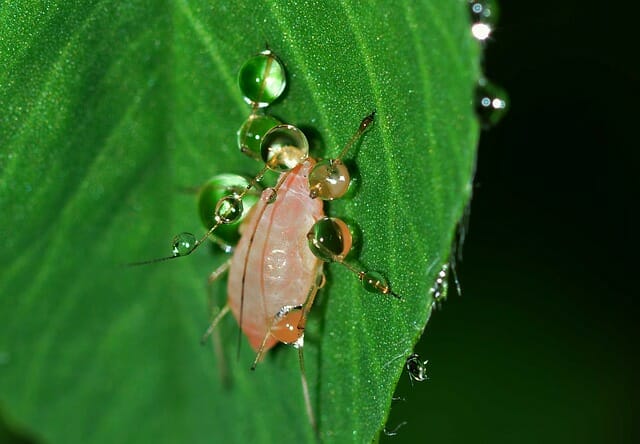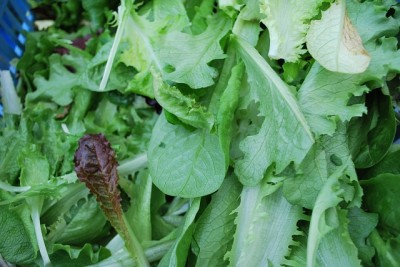
If you’ve never had an aphid infestation in your garden, consider yourself fortunate! Aphids, which exist in almost every gardening zone, are tiny insects that congregate in large numbers to suck the nutrient-rich sap out of plants.
Some, in fact, are so minute that they aren’t visible to the human eye, but they can cause massive plant damage. Aphids can eat a plant within several days. They also can spread plant diseases as they move around seeking new food sources.
It’s not always easy to identify aphids, due to their size and diversity in appearance. Aphids vary in color, from black, gray and brown to white, yellow, light green and pink. If you suspect an aphid infestation, then check the undersides of the plant’s leaves. Tiny, colored spots on the leaves likely are aphids.
The good news is that it’s fairly easy to manage aphid infestations through natural low-cost methods.
1. Spray with a garden hose
Water from a garden hose will wash aphids off plants and once dislodged, the insects can’t get back on. Keep in mind that you may need to do this daily until you no longer find aphids. Also, since there does need to be some force to the water pressure, this method is best used on sturdy, established plants, rather than on seedlings that could be knocked over or damaged by a high-pressure spray.
2. Remove by hand
It`s easy to just brush off small numbers of aphids with your hand or a cloth. Alternately, pinch off infected leaves and either dispose of them in a trash bin (not the compost pile) or submerge them in a pail of soapy water to kill the insects.
3. Apply soapy water
A mix of a mild dish detergent and water kills many different insects, including aphids. Simply mix one tablespoon of a liquid soap into one quart of water. Keep in mind that this mixture will kill beneficial insects, too (such as those that prey on aphids). For that reason, you may wish to use a sponge to apply it more directly to the aphids, rather than spraying.
4. Use essential oils
Neem oil is a natural insect repellent. To use, mix 1-2 teaspoons of neem oil with one quart of warm water. Since oil and water naturally separate, frequently shake the mixture while spraying. It’s best applied on a clear day so that it isn’t washed away by rain before it has a chance to work.
A mixture of water with thyme, peppermint, clove and rosemary essential oils creates a potent natural insecticide. Use about 4-5 drops of each essential oil to one quart of water. As with neem oil, it’s best to use warm water and to frequently shake the mixture as it is being applied.
5. Make tomato leaf or garlic oil sprays
The alkaloids in tomato leaves are toxic to aphids. It’s easy to whip up a batch of tomato leaf spray, following the directions here. Soak 1-2 cups of chopped tomato leaves in one cup of water overnight. In the morning, strain the leaves out, and then add another 1-2 cups of water to the solution before spraying.
The All-Natural Fertilizer That Can Double Your Garden Yield!
The same website has directions for a garlic oil spray. Soak 3-4 cloves of minced garlic in two teaspoons of mineral oil for 24 hours. When the time is up, strain out the garlic before adding the garlic-infused oil to one pint of water, and then add one teaspoon of dish soap. This creates a concentrated solution that needs to be further diluted (two teaspoons of solution to one pint of water) before use.
6. Use reflective mulch and row covers

Reflective mulch — such as aluminum foil — is highly effective at repelling aphids. When strips of foil are laid around the base of the plants, the foil reflects the ultraviolet rays of the sun. Aphids seeking a host plant see those ultraviolet rays rather than the blue-green light of plants. They don’t recognize the plants, and they keep moving on.
Row covers — made of transparent or semi-transparent material — can protect plants from aphids, as well. If these plants are vegetables that flower, the row covers should be removed at the flowering stage so that the plants can be pollinated.
7. Consider companion planting
If you anticipate an aphid infestation, you can grow companion plants that aphids love, to lure the insects away from the plants you don’t want them on. The companion plants should be removed and dunked in a pail of soapy water once they’re hosting an infestation. Aphids most enjoy munching on nasturtiums, asters, mums, cosmos, hollyhocks, larkspur, tuberous begonias, verbena, dahlias and zinnias.
Another way to use companion planting is to grow onions or garlic near anticipated infestation spots, since aphids don’t like the smell of alliums.
8. Introduce more beneficial insects
Ladybugs, the main predator of aphids, are available for purchase at some farm and garden supply stores, as well as online. Green lacewings also prey on aphids (and can consume up to 60 aphids an hour!). While live lacewings are not available for purchase, their eggs are.
Have you tried any of these natural insecticides and repellents on aphids? Which worked best for you? Let us know in the comments below.










